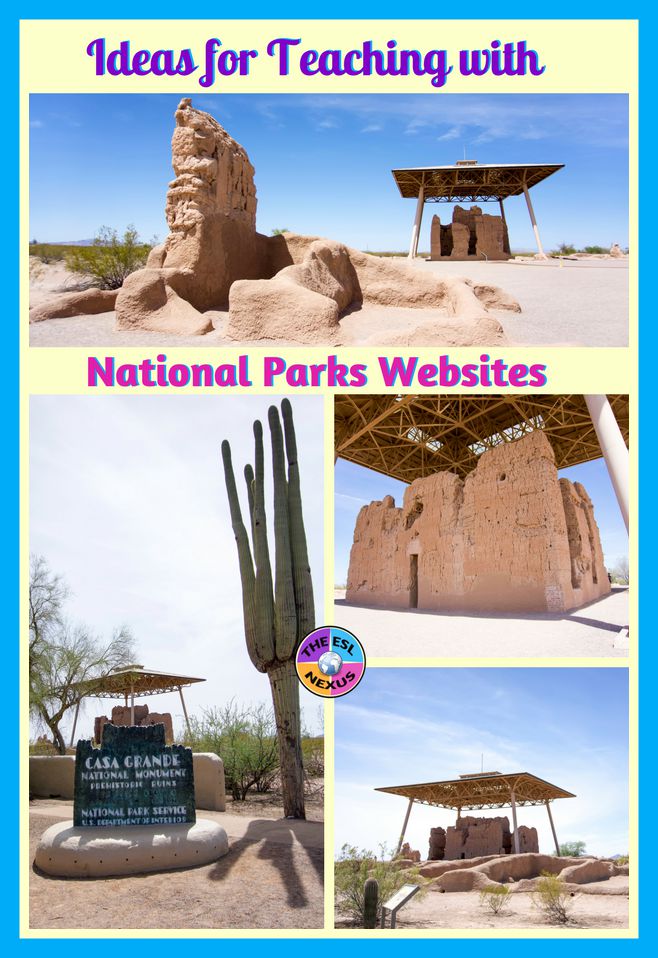To celebrate Earth Day, this past Saturday I visited Casa Grande Ruins National Monument. Located in southern Arizona, it is an archeological site with ruins from the Ancestral Sonoran Desert People culture. Also known as the Hohokam, although their descendants today prefer the former designation, you can see parts of the structures they built and learn how they survived in a harsh desert climate around 700 years ago.
Since this is National Parks Week, I thought I’d share a few of my photos and suggest a couple ways to use them with your students. Not every U.S. state has an actual national park but there are 417 sites that fall under the National Park Service system, such as national monuments, national battlefields, and national scenic trails. So there should be something in your state!
 |
| Views of Casa Grande Ruins in Arizona; source: The ESL Nexus |
To see 5 of my photographs of Casa Grande Ruins National Monument that you can use in the activities described below, just click HERE. You’ll be prompted to make a copy for yourself, then you’ll be able to see each photo individually and project it on a whiteboard if you wish. Besides the 4 photos shown in the image above, there’s another view from the front of the monument.
Below are 3 activities you can do with your students that involve using National Parks websites. To find a park (or national monument, river, trail, battleground, etc.) by state, use the National Park Service website. To find a location by type of site, use the National Park Foundation website.
Idea #1: Writing, Vocabulary
Write a sentences or a paragraph that compares and contrasts your selected site with Casa Grande. Show my photos of Casa Grande and elicit details about what students see in each picture. Then tell students to look at photos of a place in their state and write about what they see in the photos. They can write about details such as:
* The flora and fauna
* If the sites are still in use, or if they are ruins
* If they are in a rural or urban area
* Anything else they notice that can be compared or contrasted
You can choose some photos from one place in advance and project them on a whiteboard so everyone sees the same images, if you are limited in the number of devices you have that connect to the Internet. Students can work in individually, in small groups, or you can do this as a whole class activity and model how to write a good paragraph. To help your students do this kind of writing, check out my Beyond the Venn Diagram resource, which offers 2 formats for compare and contrast writing. This would work well for ELLs at lower language proficiency levels. Students at beginning proficiency levels can make lists of words in a T-chart instead of writing sentences.
Idea #2: Reading, Writing
First, go to the website for Casa Grande and with the whole class, read about it out loud. I recommend reading about its history and culture if such a section is available. Then, tell your students to select a site, read about it, and write a description of it. Students can work in small groups if there aren’t enough devices for each student. This activity is more appropriate for students at intermediate and higher levels of language proficiency. Descriptions can be 3 paragraphs if students are at an intermediate level of proficiency, longer if they are at more advanced levels.
Idea #3: Reading, Writing, Speaking, Grammar, Vocabulary
Write 5 questions about things you see in the photos of Casa Grande. They can be very simple, such as What color are the walls of the buildings? or more difficult like What are the walls made of? Also write answers to your questions. Ask the class the questions and elicit answers from student volunteers. After that, tell your students to select a site in their state and read about it, then write 5 questions, with answers, about the place. Students can work in pairs or small groups. When they’ve finished devising their questions and answers, they can ask and answer them for speaking practice.
Option 1: For beginning and low-intermediate proficiency level students, you can give sentence frames to students; for example:
When was _____ built?
Where is _____ located?
Who used _____?
What was _____ used for?
Why is _____ a national _____?
Option 2: For fun, you can assign just one site to everyone. Collect the questions and answers when students have finished writing them. Then play a game by dividing the class into 2 teams and alternate asking questions to each team. Give a point for each correct answer — the team with the most points wins.
If you’re not able to visit a national park in person this week, I hope you can use these ideas to visit one virtually!
And please check out my Gift Guide for Environmentally Aware Teachers, where you can find some great ideas for how you can protect and preserve our Earth.




